Alternative names Sate, Satai, Satti Place of origin Indonesia Serving temperature Hot | Course Entrée or main course Associated national cuisine Indonesian Origin Indonesia | |
 | ||
Region or state Southeast Asia
Suriname
Netherlands Similar Sambal, Bumbu, Bakso, Chicken meat, Nasi goreng | ||
Chicken satay with peanut sauce by vahchef vahrehvah com
Satay (/ˈsæteɪ/, /ˈsɑːteɪ/ SAH-tay), or sate in Indonesian and Malaysian spelling, is a dish of seasoned, skewered and grilled meat, served with a sauce. Satay may consist of diced or sliced chicken, goat, mutton, beef, pork, fish, other meats, or tofu; the more authentic version uses skewers from the midrib of the coconut palm frond, although bamboo skewers are often used. These are grilled or barbecued over a wood or charcoal fire, then served with various spicy seasonings. Satay can be served in various sauces, however most often they are served in a combination of soy and peanut sauce. Hence, peanut sauce are often called as satay sauce.
Contents
- Chicken satay with peanut sauce by vahchef vahrehvah com
- Chicken satay salad w asian spiralized vegetables gizzi erksine wild dish
- Origin
- Preparation
- Indonesia
- Chicken
- Beef
- Goat and other cattles
- Pork
- Fish and seafood
- Offals
- Mixture
- Eggs and vegetarian
- Others
- Malaysia
- Netherlands
- Philippines
- Singapore
- Thailand
- Fusion satay
- References
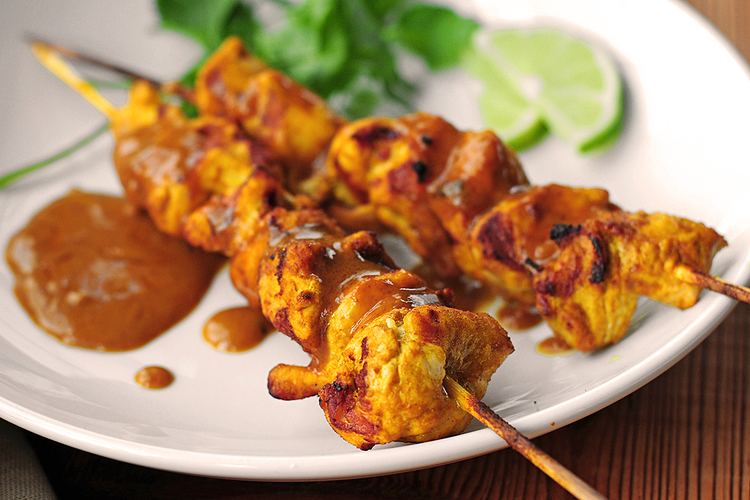
Satay originated in the Indonesian island of Java. It is available almost anywhere in Indonesia, where it has become a national dish. It is also popular in many other Southeast Asian countries, including Malaysia, Singapore, Brunei, Thailand, the Philippines, East Timor as well as in Suriname and the Netherlands, as Indonesia and Suriname are former Dutch colonies.

Satay is a very popular delicacy in Indonesia; the country's diverse ethnic groups' culinary arts (see Indonesian cuisine) have produced a wide variety of satays. In Indonesia, satay is a popular street food, it can be obtained from a travelling satay vendor, from a street-side tent-restaurant, in an upper-class restaurant, or during traditional celebration feasts. In Malaysia, satay is a popular dish—especially during celebrations—and can be found throughout the country. In Southern Philippines it is known as satti.
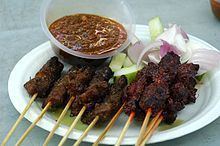
Close analogues are yakitori from Japan, chuanr from China, shish kebab from Turkey and the Middle East, shashlik from the Caucasus and sosatie from South Africa. It is listed at number 14 on World's 50 most delicious foods readers' poll compiled by CNN Go in 2011.
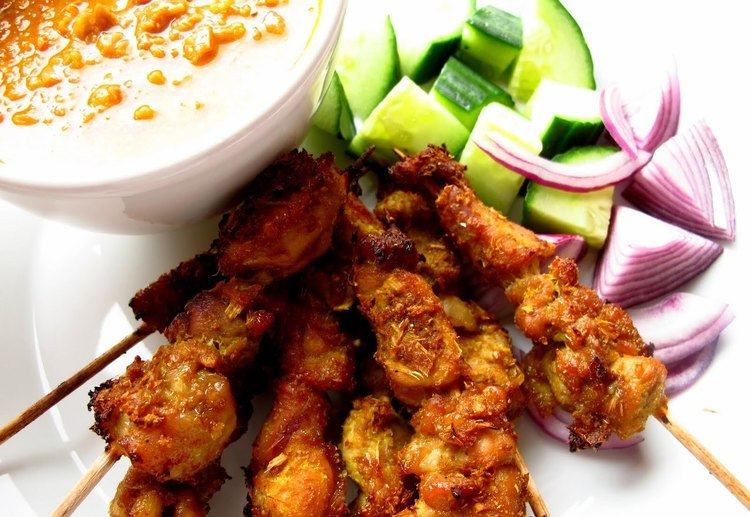
Chicken satay salad w asian spiralized vegetables gizzi erksine wild dish
Origin
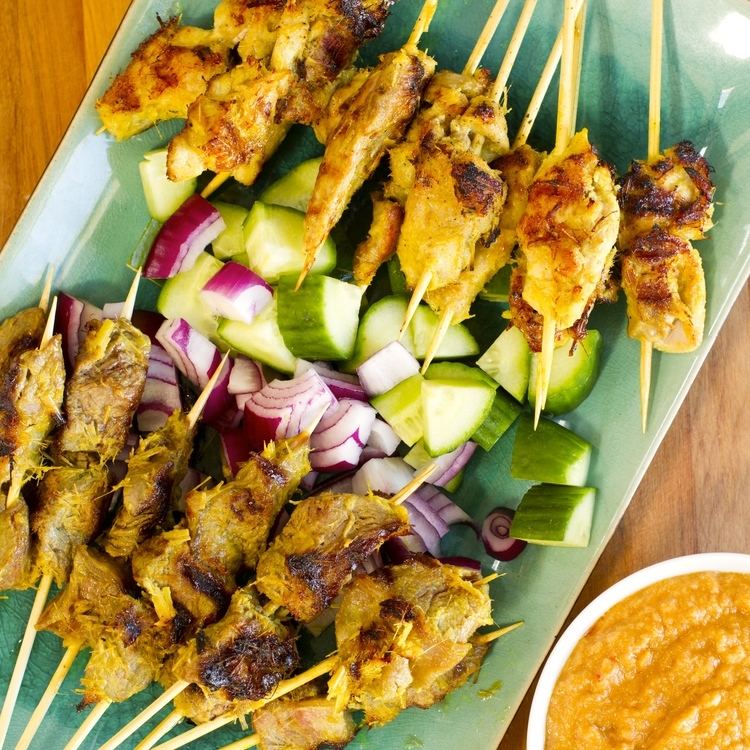
Although both Thailand and Malaysia claim it as their own, its Southeast Asian origin was in Java, Indonesia. There satay was developed from the Indian kebab brought by the Muslim traders. Even India cannot claim its origin, for there it was a legacy of Middle Eastern influence.
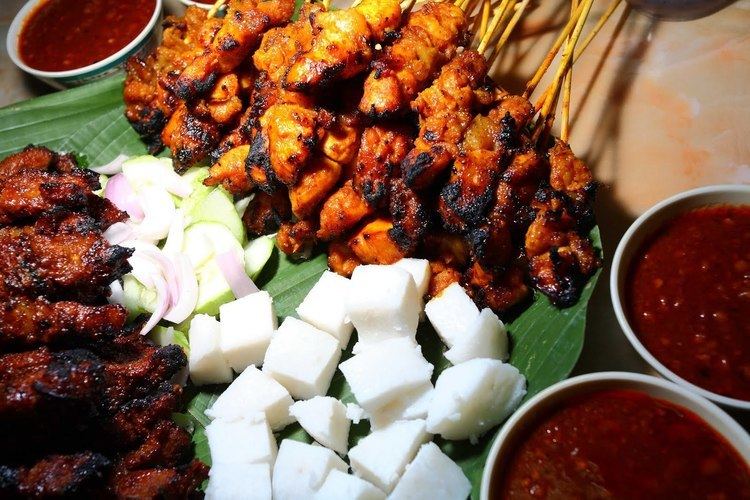
A dish with widespread popularity, the origins of satay are unclear. The word "satay" itself is thought to have been derived from Indonesian: sate and Malay: saté or satai, both perhaps of Tamil origin. Satay was supposedly invented by Javanese street vendors as an adaptation of Indian kebabs. This theory is based on the fact that satay has become popular in Java after the influx of Muslim Indian and Arabs immigrants to Dutch East Indies in the early 19th century. The satay meats used by Indonesians and Malaysians — mutton and beef — are also favoured by Arabs and are not as popular in China as are pork and chicken. During the same period, other goat-based food such as tongseng and gulai kambing spicy goat soup were also appeared in Java.

Another theory states that the word "satay" is derived from the Southern Min words sa tae bak (三疊肉), which mean "three pieces of meat". This theory is discounted, however, as traditional satay often consists of four pieces of meat and the fact that four is considered to be an inauspicious number in Chinese culture.
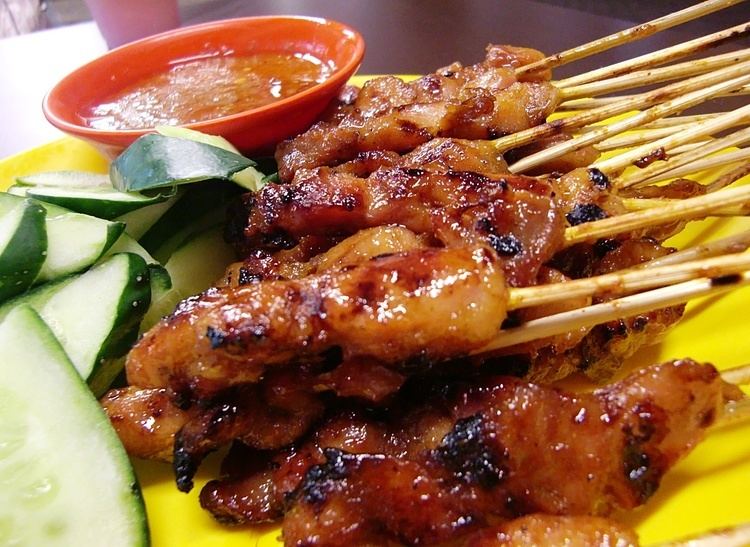
From Java (though this is difficult to prove from very few records), satay spread through the Malay Archipelago and, as a consequence, numerous variations of the dish have been developed and exist. By the late 19th century, satay has crossed the Strait of Malacca into neighbouring Malaysia, Singapore and Thailand. In the 19th century, the term migrated, presumably with Malay immigrants from the Dutch East Indies, to South Africa, where it is known as sosatie. The Dutch also brought this dish as well as many other Indonesian specialties to the Netherlands, thereby influencing Dutch cuisine even to this day.
Preparation
Turmeric is a necessary ingredient used to marinate satay, which gives the dish its characteristic yellow color. Meat commonly used includes beef, lamb, goat, mutton, pork, venison, fish, shrimp, squid, chicken, rabbit and tripe. Some have also used more exotic varieties of meat, such as turtle, crocodile, horse, lizard and snake meat.
Satay may be served with a spicy peanut sauce dip, or peanut gravy, served with slices of lontong or ketupat (rice cakes), and relished with acar (pickles) consist of slivers of onions, carrots and cucumbers in vinegar, salt and sugar solution. Mutton satay is usually served with kecap manis (sweet soy sauce) instead of peanut sauce. Pork satay can be served in a pineapple-based satay sauce or cucumber relish. An Indonesian version uses a soy sauce-based dip.
Indonesia
Indonesia is the home of satay (known as sate in Indonesian and pronounced similar to the English "satay"), and satay is a widely renowned dish in almost all regions of Indonesia; it is considered the national dish and one of Indonesia's best dishes. Satays, in particular, are a staple in Indonesian cuisine, served everywhere from street carts to fine dining establishments, as well as in homes and at public gatherings. As a result, many variations have been developed throughout the Indonesian Archipelago. In Indonesia there are some restaurants that specialized on serving various kinds of satay and present it as their specialty, such as Sate Ponorogo Restaurant, Sate Blora Restaurant, and also chains of Sate Khas Senayan restaurants, previously known as Satay House Senayan. In Bandung, the West Java Governor's office is popularly called Gedung Sate (Indonesian: Satay building) to refer the satay-like pinnacle on its roof. Indonesia has the richest variations of satay in the world. The satay variants in Indonesia usually named after the region its originated, the meats, parts or ingredients its uses, also might named after the process or method of cooking.
Chicken
Beef
Goat and other cattles
Pork
Fish and seafood
Offals
Mixture
Eggs and vegetarian
Others
Malaysia
Known as sate in Malay (and pronounced similarly to the English "satay"), it can be found throughout all the states of Malaysia in restaurants and on the street, with hawkers selling satay in food courts and Pasar malam. While the popular kinds of satay are usually beef and chicken satays, different regions of Malaysia have developed their own unique variations. Sate is often associated with Muslim Malays, but pork sate is also available at non-halal Chinese eating establishments.
There are a number of well-known satay outlets in Kajang, Selangor which is dubbed the Sate City in the country. Sate Kajang is a generic name for a style of sate where the meat chunks are bigger than normal, and the sweet peanut sauce served along with a portion of fried chilli paste. Given its popularity, sate Kajang is now found throughout Malaysia. Stalls and restaurants around Kajang offer not only the more traditional chicken or beef satay, but also more exotic meats such as venison, rabbit or fish, as well as gizzard, liver, and a number of other variations.
Another type of meat satay is the sate lok-lok from Penang and sate celup (dip satay) from Malacca. Both are Malaysian Chinese fusions of the hotpot and the Malay satay. Pieces of raw meat, tofu, century eggs, quail eggs, fish cake, offal or vegetables are skewered on bamboo sticks. These are cooked by being dipped in boiling water or stock. The satay is then eaten with a sweet, dark sauce, sometimes with chilli sauce as an accompaniment. If the satay is eaten with satay sauce, it is called sate lok-lok. If the satay is cooked with boiling satay peanut sauce, it is called sate celup. Both dishes are available from street vendors or in certain restaurants, and the majority are not halal. Customers use a common container containing boiling stock to personally cook their satay. Sauces are either served in common containers or individually. There are usually no tables near street vendors, and customers thus tend to gather around the food cart.
Netherlands
Known as saté or sateh, it is fully adapted in Dutch everyday cuisine. Pork, and chicken satays, are almost solely served with spicy peanut sauce, and are readily available in snackbars and supermarkets. Versions with goat-meat (sateh kambing) and sweet soy sauce are available in Indonesian restaurants and take-aways. Pork or chicken satay in peanut sauce, with salad and French-fries, is popular in pubs or eetcafes.
Another favourite in Dutch snackbars is the satékroket, a croquette made with a peanut sauce and shredded meat ragout.
Philippines
In the majority of the Philippines, satay (especially pork or chicken) is referred to by the generic English name "barbecue" (usually shortened to "BBQ"). This association is the source of the portmanteau names for other popular street foods that are also served skewered, such as banana cue ("banana" + "barbecue") and camote cue ("camote (sweet potato) + barbecue").
Satay is known as Satti in the Southern Philippines (especially in the regions of Zamboanga, Sulu Archipelago and Tawi-Tawi). Satti is usually made from chicken or beef among Muslim Filipinos. It is particularly popular in Tausug cuisine and is commonly eaten as breakfast in restaurants which specialize in satti. It is typically served with ta'mu (pusô in other Philippine languages) and a bowlful of warm sauce.
Offal-based versions of satay are also commonly sold in the Philippines as street food. The most popular are made from chicken or pork intestines known as isaw. Other variants use liver, tripe, lungs, chicken heads and feet, cubes of coagulated pork blood, and pork ears, among others.
Annatto seeds and banana ketchup-based sauces are also widely used which gives the meat a vibrant orange or red color.
Singapore
Satay is one of the earliest foods to be associated with Singapore; it has been associated with the city since the 1940s. Previously sold on makeshift roadside stalls and pushcarts, concerns over public health and the rapid development of the city led to a major consolidation of satay stalls at Beach Road in the 1950s, which came to be collectively called the Satay Club. They were moved to the Esplanade Park in the 1960s, where they grew to the point of being constantly listed in tourism guides.
Open only after dark with an open air or "al fresco" dining concept, the Satay Club defined how satay is served in Singapore since then, although they are also found across the island in most hawker stalls, modern food courts, and upscale restaurants at any time of the day. Moved several times around Esplanade Park due to development and land reclamation, the outlets finally left the area permanently to Clarke Quay in the late 1990s to make way for the building of the Esplanade - Theatres on the Bay.
Several competing satay hotspots have since emerged, with no one being able to lay claim to the reputation the Satay Club had at the Esplanade. While the name has been transferred to the Clarke Quay site, several stalls from the original Satay club have moved to Sembawang in the north of the city. The satay stalls which opened at Lau Pa Sat are popular with tourists. Served only at night when Boon Tat Street is closed to vehicular traffic and the stalls and tables occupy the street, it mimics the open-air dining style of previous establishments.
Other notable outlets include the ones at Newton Food Centre, East Coast Park Seafood Centre and Toa Payoh Central.
The common types of satay sold in Singapore include Satay Ayam (chicken satay), Satay Lembu (beef satay), Satay Kambing (mutton satay), Satay Perut (beef intestine), and Satay Babat (beef tripe).
Singapore's national carrier, Singapore Airlines, also serves satay to its First and Raffles Class passengers as an appetizer.
Thailand
Satay (Thai: สะเต๊ะ, pronounced [sā.téʔ]) is a popular dish in Thailand. Usually served with peanut sauce and achat, Thai satay have various recipes, from chicken, beef, and pork, to vegetarian variants that employ soy protein strips or tofu. Satay can easily be found in virtually any Thai restaurant worldwide. Satay come to Thailand via Indonesia. Because Thai cuisine is heavily marketed internationally and has attracted world culinary attention earlier than Indonesian cuisine, despite its Indonesian origin, there is a widespread misconception abroad that satay originated from Thailand. As a result, it is most frequently associated with Thai food.
Fusion satay
A popular misconception is that the term "satay" is a peanut sauce. Traditionally, satay referred to any grilled skewered meats with various sauces; it is not necessarily served solely with peanut sauce. However, since the most popular variant of satay is chicken satay in peanut sauce (Sate Madura in Indonesia, Sate Kajang in Malaysia, and Thai chicken satay with peanut sauce), in modern fusion cuisine the term "satay" has shifted to satay style peanut sauce instead.
For example, the fusion "satay burger" refers to beef hamburger served with so-called "satay sauce", which is mainly a kind of sweet and spicy peanut sauce or often replaced with gloppy peanut butter. The Singapore satay bee hoon is actually rice vermicelli served in peanut sauce. The American-Thai fusion fish fillet in satay sauce also demonstrates the same trend. The fusion French cuisine Cuisses de Grenouilles Poelees au Satay, Chou-fleur Croquant is actually frog legs in peanut sauce. The Indomie instant noodle is also available in satay flavour, which is only the addition of peanut sauce in its packet.
